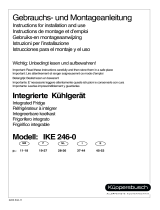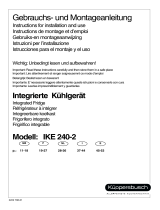2 Gedruckt auf umweltschonend hergestelltem Papier
Sicherheitshinweise . . . . . . . . . . . . . . . . . . . . . . . . . . . . . . . . . . . . . . . . . . . . . . . . . . . . . . . . . . . . . . . . . . . . . .2
Entsorgung . . . . . . . . . . . . . . . . . . . . . . . . . . . . . . . . . . . . . . . . . . . . . . . . . . . . . . . . . . . . . . . . . . . . . . . . . . . . .3
Gebrauch Vor Inbetriebnahme . . . . . . . . . . . . . . . . . . . . . . . . . . . . . . . . . . . . . . . . . . . . . . . . . . . . . . . . . . . . . .3
Bedienungsblende / Inbetriebnhame / Temperaturregelung / Schnellgefriervorgang / Alarmlampe . . . . . . . . .4
Akustisches Alarmsignal . . . . . . . . . . . . . . . . . . . . . . . . . . . . . . . . . . . . . . . . . . . . . . . . . . . . . . . . . . . . . . . . . .4
Gefrierkalender / Gefrierabteilausstattung / Tips . . . . . . . . . . . . . . . . . . . . . . . . . . . . . . . . . . . . . . . . . . . . . . .5
Wartung Abtauen / Reinigung . . . . . . . . . . . . . . . . . . . . . . . . . . . . . . . . . . . . . . . . . . . . . . . . . . . . . . . . . . . . . .6
Wenn etwas nicht funktioniert / Kundendienst und Ersatzteile / Technische Angabe . . . . . . . . . . . . . . . .7
Installation Aufstellung / Elektrischer Anschluss . . . . . . . . . . . . . . . . . . . . . . . . . . . . . . . . . . . . . . . . . . . . . . . .8
Türanschlag wechseln . . . . . . . . . . . . . . . . . . . . . . . . . . . . . . . . . . . . . . . . . . . . . . . . . . . . . . . . . . . . . . . . . . .9
Einbau . . . . . . . . . . . . . . . . . . . . . . . . . . . . . . . . . . . . . . . . . . . . . . . . . . . . . . . . . . . . . . . . . . . . . . . . . . . . . . . . .9
Inhalt
Sicherheitshinweise
Bevor Sie Ihr neues Kältegerät in Betrieb nehmen,
lesen Sie bitte diese Gebrauchsanweisung
aufmerksam durch.
Diese sind Sicherheitshinweise. Wir ersuchen Sie
daher, die folgenden Punkte vor der Installation
des Gerätes und seiner Inbetriebnahme
aufmerksam durchzulesen.
Es wird empfohlen, diese Gebrauchsanweisung gut
aufzubewahren und bei einem eventuellen Verkauf
des Gerätes dem neuen Besitzer auszuhändigen.
Benutzung im Haushalt
• Die Kühl- und/oder Gefrierschränke sind zur
Einlagerung und/oder zum Einfrieren von
Lebensmitteln bestimmt.
• Vor der Installation sicherstellen, dass das Gerät
nicht beschädigt ist. Mögliche Transportschäden
sind dem Händler unverzüglich mitzuteilen.
•
Das Gerät ist schwer. Scharfe Metallkanten am
Gerät hinten und unten stellen ein Verletzungsrisiko
dar. Beim Aufstellen oder Verschieben sind
Schutzhandschuhe zu tragen.
• Sollte die Installation des Gerätes eine Änderung
der elektrischen Hausinstallation verlangen, so darf
diese nur von Elektro-Fachkräften durchgeführt
werden.
• Nach Installation des Gerätes kontrollieren, dass
dieses nicht auf dem Anschlusskabel aufliegt.
• Man sollte mindestens 2 Std. warten, bevor das
Gerät in Betrieb genommen wird, damit das
Kältemittel zurückströmen kann.
• Keine Elektrogeräte (z.B. Eismaschinen) in das
Gerät stellen.
• Es sollten keine kohlensäurehaltigen Getränke in
das Gefrier- bzw. Frosterfach eingestellt werden,
sie könnten platzen.
• Speiseeis und Eiswürfel nicht unmittelbar aus dem
Gefrierfach in den Mund nehmen. Sehr kaltes Eis
kann an Lippen oder Zunge festfrieren und
Verletzungen verursachen.
• Tiefkühlgut nicht mit nassen Händen berühren. Die
Hände könnten daran festfrieren.
• Tritt eine Störung oder ein Defekt ein, versuchen
Sie nicht, das Gerät selbst zu reparieren.
Elektrogeräte dürfen nur von Elektro-Fachkräften
repariert werden, da durch unsachgemässe
Reparaturen erhebliche Folgeschäden entstehen
können. Sich an die nächstgelegene
Kundendienststelle wenden und nur Original-
Ersatzteile anfordern.
Sicherheit für Kinder
• Die Teile des Verpackungsmaterials (z.B.
Kunststoffhüllen, Polystyrol) können für Kinder
gefährlich werden. Erstickungsgefahr!
• Im Falle der Entsorgung des Gerätes ist das
Anschlusskabel durchzutrennen und der
Türverschluss unbrauchbar zu machen, damit sich
spielende Kinder nicht im Gerät einschließen
können.
Umweltnormen
• Das Gerät darf nicht mit dem Hausmüll oder
Sperrmüll entsorgt werden. Auskunft über
Abholtermine oder Sammelplätze gibt die örtliche
Gemeindeverwaltung an.
Entsorgung von Altgeräten
Das Symbol auf dem Produkt oder seiner
Verpackung weist darauf hin, dass dieses Produkt
nicht als normaler Haushaltsabfall zu behandeln ist,
sondern an einem Sammelpunkt für das Recycling
von elektrischen und elektronischen Geräten
abgegeben werden muss. Durch Ihren Beitrag zum
korrekten Entsorgen dieses Produkts schützen Sie
die Umwelt und die Gesundheit Ihrer Mitmenschen.
Umwelt und Gesundheit werden durch falsches
Entsorgen gefährdet. Weitere Informationen über das
Recycling dieses Produkts erhalten Sie von Ihrem
Rathaus, Ihrer Müllabfuhr oder dem Geschäft, in dem
Sie das Produkt gekauft haben.























